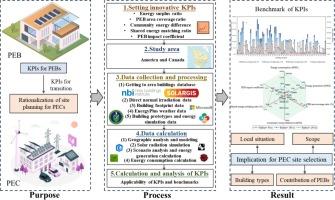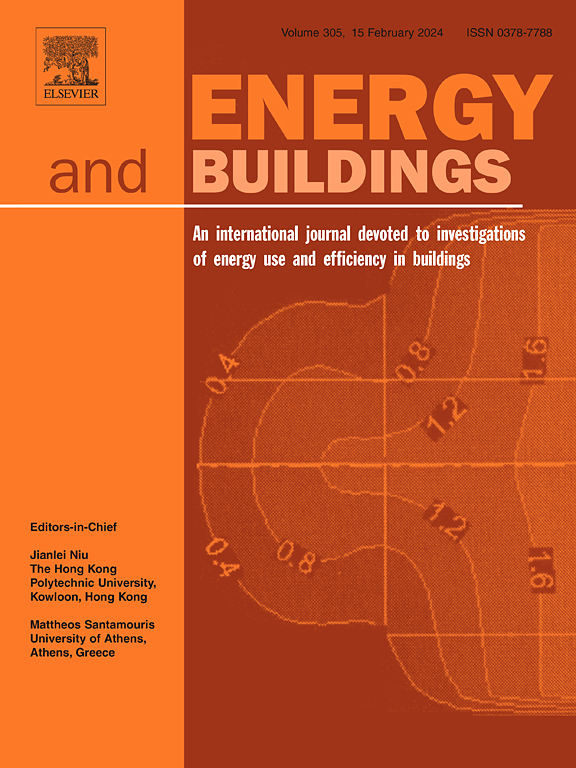将正能量建筑转变为正能量社区:利用性能指标进行场地规划评估
IF 6.6
2区 工程技术
Q1 CONSTRUCTION & BUILDING TECHNOLOGY
引用次数: 0
摘要
在社区内利用正能量建筑(PEBs)的能源盈余和技术进步,提供了从 PEBs 向正能量社区(PECs)过渡的合理途径。本研究提出了一套合理的绩效指标(KPIs),用于简化基于现有 PEBs 的场地规划评估,旨在过渡到 PECs,以实现离网状态下的能源自治。建议的关键绩效指标包括能源盈余率、PEB 区域覆盖率、社区能源差异、共享能源匹配率和 PEB 影响系数。为验证这些关键绩效指标,我们选择了北美真实数据库提供的 81 个 PEB 作为样本,并进行了相关的地理分析和模拟。考虑了四种光伏安装方案和三种半径范围的建筑发电量和能耗。结果表明,通过 PEB 建立 PEC 是很有前景的。在现有社区中,从 PEB 过渡到 PEC 的物理边界可确定为 150 米至 250 米。研究还发现,在能源恢复能力规划过程中,教育建筑应与住宅建筑紧密结合。关键绩效指标为 PEC 的初步选址提供了至关重要的见解,为 PEC 的开发提供了实用指导,并为通过 PEB 规划 PEC 的战略决策提供了信息。这项研究的结果为城市规划者、决策者、开发商和研究人员等利益相关者提供了可操作的指导,有助于创建可持续的、积极的能源社区。本文章由计算机程序翻译,如有差异,请以英文原文为准。

Transitioning positive energy buildings towards positive energy Communities: Leveraging performance indicators for site planning assessments
Harnessing energy surpluses and technological advances from positive energy buildings (PEBs) within a community offers a logical transition pathway from PEBs to positive energy communities (PECs). This study proposes a set of reasonable performance indicators (KPIs) for streamlining site planning assessments based on existing PEBs, aiming to transition to PECs for achieving energy autonomy in off-grid states. The proposed KPIs include energy surplus ratio, PEB area coverage ratio, community energy difference, shared energy matching ratio, and PEB impact coefficient. A sample of 81 PEBs provided by a real database in North America was selected for testifying these KPIs, and relevant geographic analyses and simulations were performed. Four PV installation scenarios and three radius ranges were considered for building energy generation and energy consumption. The results show that the establishment of a PEC through a PEB is promising. In existing communities, the physical boundary of the transition from PEB to PEC can be determined to be between 150 and 250 m. The study also found that educational buildings should be closely integrated with residential buildings in the energy resilience planning process. KPIs offer crucial insights for initial PEC site selection, offering practical guidance for PEC development and informing strategic decisions in planning PECs through PEBs. This study’s findings serve as actionable guidance for stakeholders, such as urban planners, policymakers, developers, and researchers, facilitating the creation of sustainable and energy-positive communities.
求助全文
通过发布文献求助,成功后即可免费获取论文全文。
去求助
来源期刊

Energy and Buildings
工程技术-工程:土木
CiteScore
12.70
自引率
11.90%
发文量
863
审稿时长
38 days
期刊介绍:
An international journal devoted to investigations of energy use and efficiency in buildings
Energy and Buildings is an international journal publishing articles with explicit links to energy use in buildings. The aim is to present new research results, and new proven practice aimed at reducing the energy needs of a building and improving indoor environment quality.
 求助内容:
求助内容: 应助结果提醒方式:
应助结果提醒方式:


